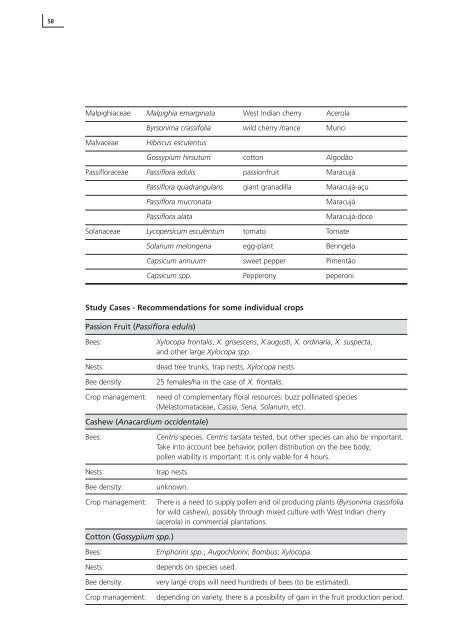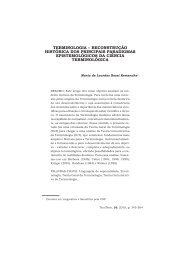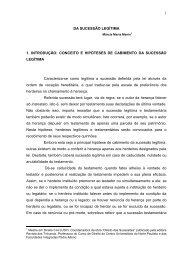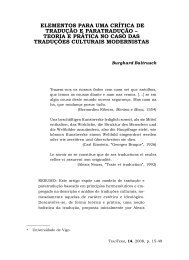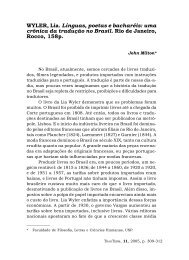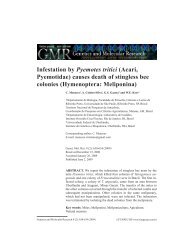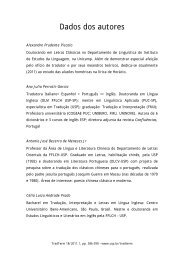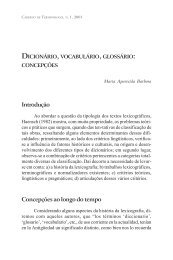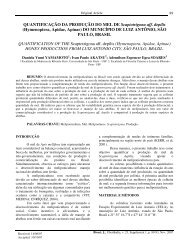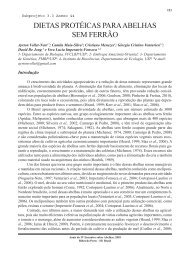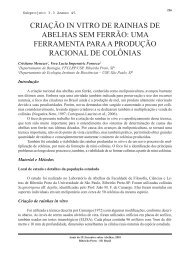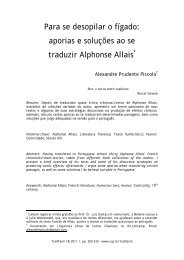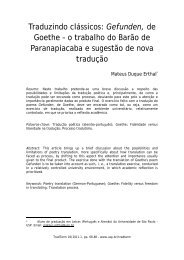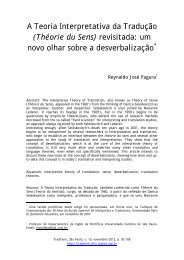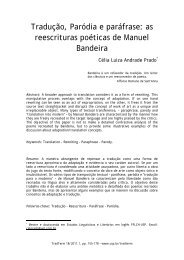Bees as pollinators in Brazil - USP
Bees as pollinators in Brazil - USP
Bees as pollinators in Brazil - USP
You also want an ePaper? Increase the reach of your titles
YUMPU automatically turns print PDFs into web optimized ePapers that Google loves.
58<br />
Malpighiaceae<br />
Malvaceae<br />
P<strong>as</strong>sifloraceae<br />
Solanaceae<br />
Study C<strong>as</strong>es - Recommendations for some <strong>in</strong>dividual crops<br />
P<strong>as</strong>sion Fruit (P<strong>as</strong>siflora edulis)<br />
<strong>Bees</strong>: Xylocopa frontalis, X. grisescens, X.augusti, X. ord<strong>in</strong>aria, X. suspecta,<br />
and other large Xylocopa spp..<br />
Nests: dead tree trunks, trap nests, Xylocopa nests.<br />
Bee density: 25 females/ha <strong>in</strong> the c<strong>as</strong>e of X. frontalis.<br />
Crop management: need of complementary floral resources: buzz poll<strong>in</strong>ated species<br />
(Mel<strong>as</strong>tomataceae, C<strong>as</strong>sia, Sena, Solanum, etc).<br />
C<strong>as</strong>hew (Anacardium occidentale)<br />
<strong>Bees</strong>: Centris species. Centris tarsata tested, but other species can also be important.<br />
Take <strong>in</strong>to account bee behavior, pollen distribution on the bee body;<br />
pollen viability is important: it is only viable for 4 hours.<br />
Nests: trap nests.<br />
Bee density: unknown.<br />
Crop management: There is a need to supply pollen and oil produc<strong>in</strong>g plants (Byrsonima cr<strong>as</strong>sifolia<br />
for wild c<strong>as</strong>hew), possibly through mixed culture with West Indian cherry<br />
(acerola) <strong>in</strong> commercial plantations.<br />
Cotton (Gossypium spp.)<br />
Malpighia emarg<strong>in</strong>ata<br />
Byrsonima cr<strong>as</strong>sifolia<br />
Hibiscus esculentus<br />
Gossypium hirsutum<br />
P<strong>as</strong>siflora edulis<br />
P<strong>as</strong>siflora quadrangularis<br />
P<strong>as</strong>siflora mucronata<br />
P<strong>as</strong>siflora alata<br />
Lycopersicum esculentum<br />
Solanum melongena<br />
Capsicum annuum<br />
Capsicum spp.<br />
<strong>Bees</strong>: Emphor<strong>in</strong>i spp.; Augochlor<strong>in</strong>i; Bombus; Xylocopa.<br />
Nests: depends on species used.<br />
West Indian cherry<br />
wild cherry /nance<br />
cotton<br />
p<strong>as</strong>sionfruit<br />
giant granadilla<br />
tomato<br />
egg-plant<br />
sweet pepper<br />
Pepperony<br />
Acerola<br />
Murici<br />
Algodão<br />
Maracujá<br />
Maracujá-açu<br />
Maracujá<br />
Maracujá-doce<br />
Tomate<br />
Ber<strong>in</strong>gela<br />
Pimentão<br />
peperoni<br />
Bee density: very large crops will need hundreds of bees (to be estimated).<br />
Crop management: depend<strong>in</strong>g on variety, there is a possibility of ga<strong>in</strong> <strong>in</strong> the fruit production period.


